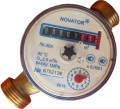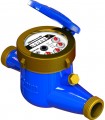Mechanical
Features of the design of a mechanical water metre (see "Principle of operation").
— Turbine. Metres in which water during operation passes through a turbine — a wheel with blades, the axis of rotation of which is parallel to the direction of flow. This mechanism is somewhat more expensive than the impeller (see below), but it allows you to effectively cope with the intense flow of water while providing good accuracy. Therefore, in mechanical metres with a nominal diameter (see "Diameter (DN)") of more than 50 mm, only turbines are installed; in 50 mm models, turbines are found along with impellers, and in devices of a smaller diameter they are not used at all. Also, note that all models with this type of metre are industrial (see "Type").
— Impeller. Water metres in which water during operation passes through an impeller — a wheel with blades, the axis of rotation of which is directed perpendicular to the flow of water. This design is simpler and cheaper than the turbine design (see above), but it has lower accuracy and is not well suited for large volumes of water. Therefore, only models with a nominal diameter (see "Diameter (DN)") of 50 mm or less are equipped with impellers; these are, in particular, all household appliances (see "Type") with a mechanical principle of operation, as well as some industrial metres of low productivity.
— Single jet. Metres in which water enters the measuring mechanism in a continuous stream, without divid...ing into separate jets. Compared to the multi-jet devices described below, such devices are much simpler, cheaper and more compact, but they are more prone to errors associated with uneven flow. This is not a serious drawback for domestic use but is unacceptable for accurate calculations. Therefore, only household metres are made single-jet (see "Type").
— Multi-jet. In metres with this feature, the water flow entering the impeller or turbine (see above) is pre-cut into several jets. Due to this, the most uniform effect on the measuring mechanism is ensured and the turbulence that occurs in the pipeline is compensated, which significantly increases the accuracy of measurements. The main disadvantages of multi-jet devices are the complexity of the design and higher price than that of single-jet ones. Thus, it makes no sense to use such metres for household measurements; but in the industrial sector (see "Type"), where accuracy is key, they are extremely common.
— Dry. Dry-running metres are called metres in which the counting mechanism is completely isolated from the water flowing through the device. Unlike wet-running devices, where this mechanism is in contact with water, in dry-running models, most of the hardware is separated from the water-measuring section by a sealed partition, and rotation is transmitted through a special magnetic coupling. This arrangement complicates and increases the cost of the design; on the other hand, metres are more reliable, resistant to dirt and durable than wet metres. In addition, they can provide some special features — for example, disconnecting the measuring mechanism without removing the entire device.
— Combined. Combined models are actually two metres in one case, connected in parallel. One of these metres is designed for small volumes of water, the second for intensive consumption; switching between them is carried out automatically — by a special valve that reacts to the flow rate. This design is not cheap, but it allows you to significantly expand the effective range of measurements and achieve high accuracy at both low and high flow rates. It makes sense to use combined models where the intensity of water consumption can vary over a very wide range, which cannot be covered by a conventional metre.
Division value
The division value on the measuring scale of the water metre.
The division price is the minimum measurement step, the difference between two adjacent smallest units, in other words, the smallest difference in readings that the metre can display. The smaller this difference, the more detailed data the device produces. For example, a value of 0.01 m³ allows you to display data with an accuracy of the second decimal place — that is, such a metre will show, for example, a change in the amount of water consumed from 0.02 m³ to 0.03 m³, but will not perceive the difference between 0.022 m³ and 0.028 m³ (readings will remain at the level of 0.02 m³). However, modern water metres — even household ones — for the most part, have a lower division price, from 0.001 m³ and below.
Sensitivity threshold, less than
Sensitivity threshold for this water metre model.
The sensitivity threshold is the lowest flow rate at which the device begins to respond to the movement of water and record the flow; at a lower speed, the measuring mechanism simply does not distinguish between flow and still water. The lower this indicator, the less likely it is that, at low consumption, water will be consumed without accounting. In household models (see "Type") the sensitivity threshold does not exceed 40 L/h, there are also much lower figures — 10 L/h, or even 5 L/h. In industrial metres designed for large industries, there are values of hundreds of litres per hour.
Installation
Installation method provided for by the design of the metre.
Modern metres can be designed for horizontal or vertical installation. The division, in this case, is carried out according to the location of the pipe into which the device is built; in the first case, the device is located with the scale up or to the side, in the second — only with the scale to the side.
The choice for this indicator depends primarily on the planned installation site of the metre. There is an opinion that a
vertical installation contributes to greater accuracy, but it all depends on the specific model of the device. It is also worth noting that nowadays, horizontal placement is most popular; purely "vertical" models are rarely produced, and universal solutions that allow both installation methods are more common.
Dimensions
General water metre dimensions in length, depth and height. Sometimes only one size can be indicated in this paragraph — the length: it is most important during installation, it is the length that is taken into account when choosing the required distance between the ends of the pipes. At the same time, it is worth remembering that between these ends, not only the metre itself is most often located, but also other devices and parts: connecting fittings, a valve, a coarse filter, a check valve, etc. Details on this can be found in special sources; here we note that for some models, the specifications separately indicate the length with complete mounting fittings (see below). Without fittings, the length can be from
80 – 100 mm in the most compact devices to
250 mm or more in the largest.
Depth and height, in turn, allow you to estimate how much free space around the pipe is needed for the normal placement of the metre.
Length with fittings
The length of the water metre with complete mounting fittings installed on it.
The fittings are used when installing models with a threaded connection (see "Connection"). They are short pipes screwed onto the inlet and outlet of the metre and play the role of a kind of adapter between the device and other elements of the system (for example, a coarse filter and a check valve for a traditional household metre). Knowing the length with fittings installed, it is easier to calculate the required distance between the ends of the pipes: when calculating, you do not need to separately take into account the length of the fittings, they are already taken into account in this size.
Rotating counter mechanism
The ability to rotate the counter scale around the vertical axis.
The rotating counter mechanism is found mainly in mechanical counters (see "Principle of operation") with the possibility of both horizontal and vertical installation. The meaning of this function is that for different situations, the optimal, most convenient for the user, scale location will also be different. So, when placed horizontally, it is most convenient to turn it parallel or at a slight angle to the pipes, and when placed vertically, perpendicular to them; there may be other, more specific nuances.
Protective cover
The presence of a special
protective cover on the water metre scale. Usually, such a cover is closed, it is opened only to check the readings. Such a detail protects, first of all, the transparent plastic with which the scale is covered — from bumps, scratches and dirt; thanks to this, the plastic remains transparent for a long time, does not become foggy and does not interfere with reading data from the scale. However, the role of the cover is not limited to this, it often provides additional protection for the case as a whole; and in some models, sensors are mounted in the cover to transmit data from the metre, used in remote control systems. Note that all these functions can be provided both in industrial and household metres (see "Type").
Body material
The material from which the metre body is made.
— Brass. Brass varieties used in water metres are strong, reliable, durable and resistant to corrosion while being relatively inexpensive. However, due to its mechanical specs, brass is not suitable for flange connections (see above). Therefore, this material is used exclusively in threaded metres — that is, models with a relatively small throughput, mainly household ones (see "Type"), although there are exceptions.
— Cast iron. One of the key advantages of cast iron in the case of water metres is that, due to its hardness, flanged connections can be made from this material. Therefore, all industrial metres using a flange are made exclusively of cast iron. In addition, this material is also found in less performant models, with a threaded connection — including household ones (see "Type"). Such devices differ from their brass counterparts, on the one hand, in greater strength and reliability, on the other hand, in significant weight and increased cost.

